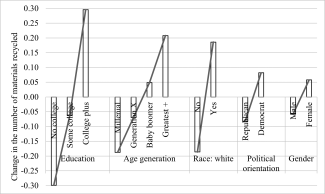Household recycling can reduce demand for virgin materials, limit waste sent to landfills, and lessen the cost of producing metal-, glass-, and paper-containing products. Understanding the policies most conducive to promoting recycling is key to success. The November 2023 issue of ELR—The Environmental Law Reporter looks at the efficacy of state and local recycling policies and identifies contexts where the greatest improvements are possible. Using the most comprehensive data set on U.S. household recycling behavior, authors Joel Huber, W. Kip Viscusi, and Jason Bell quantify the relative impact of characteristics associated with recycling in different populations, under different government rules, and different access to resources and amenities.
Using Objective Characteristics to Target Household Recycling Policies presents a deep dive into the characteristics that are most influential, thus highlighting the relative performance of different policies and potential targets for improvement. Its data set includes more than 380,000 observations of annual household recycling behavior, based on information for more than 145,000 nationally representative households in nearly 3,000 counties across 50 states (plus the District of Columbia) spanning 10 years.
According to the authors, “establishing consistent objective measures that predict household recycling provides a framework that can be directly actionable for recycling policy. Knowing the demographics of who currently recycles provides a contextual focus for education campaigns for those who do not, and for infrastructure and recycling laws that will encourage households to change their behavior. Households can be identified by their resources, housing types, and county amenities. These identifiable characteristics can be used as inputs in the design of recycling policies.”

For example, education is the most predictive individual characteristic. The authors found that people without a college education recycle materials -0.30 below that of the average. For those with some college education, this rises close to average. For college graduates, the number of materials recycled increases +0.30. Meanwhile, age is less influential on average recycling rates. Millennials (born after 1980) have the lowest rate of recycling, followed by Generation X (1965-1980), baby boomers (1946-1964), and peaking with the most participation from those born before 1946. Of the 21 characteristics examined, other influential characteristics include mandatory recycling laws, race, income, and homeownership. Meanwhile, gender, political orientation, and marital status were less influential.
The authors advise that “if society wants to encourage recycling across the board, greater change will occur if counties focus support for household recycling in areas with lower income and by increasing recycling requirements for rental apartments. For their part, states could provide additional resources for rural and low-income counties in return for effective recycling programs. While much research into recycling has focused on the actions of households, more attention is needed on the critical public policy roles of counties and states.”
ELI is making this featured ELR article available free for download. To access all that ELR has to offer, including the full content of ELR—The Environmental Law Reporter and its archive, you must have a subscription.
To learn more, visit www.elr.info.
